We’re going to describe and show you the sequence of events related to the Meadows Carpet Fire case.
Prosecution has provided (partial) building surveillance footage from only 4 cameras; this partial footage was only provided to the Defense over half a year after the fire. Six months after the fire, when investigators were asked to follow up on this case (per the Defense’s continuous requests for ALL of the building surveillance footage from ALL cameras (15 indoor and 2 outdoor)), they stated they were “not able to locate any video for the incident from the apartments known as Meadows West.”
The limited surveillance footage that has been provided by Prosecution says a lot about the case to exonerate Ron Makin.
On May 19, 2018, there was a small fire on the carpet in a common-access hallway and attached emergency-exit stairwell in the Meadows Apartments (in Bountiful, UT), a government housing apartment complex for low-income elderly and disabled residents.
Ron Makin has moderate speech difficulties. He is also physically disabled and has health issues. He lived with his handicapped wife and small dogs in the Meadows Apartments, until he was accused, arrested, and instantly evicted—without evidence and witnesses—for starting the fire. (His dependent, handicapped wife was consequently, immediately evicted as well.)
The fire alarm activated at 11:47pm.
Ron Makin was charged with Aggravated Arson for this fire, despite not being near the fire area after 10:07pm, as shown by multiple surveillance cameras. Ron maintains that he’s innocent and the facts support that.
Ron passed through the fire area 1hr40min before the fire alarm! These separate events are tenuously linked, at best.
This fire didn’t burn like a gasoline fire. It was a small, mild fire with no explosion, pressure wave, or thermal or luminous blast. It was fully extinguished within a few minutes of the alarm, before firemen arrived! The fire in the stairwell simply self-extinguished.
Investigators claim it was a gasoline fire, but no witnesses ever claimed that they smelled gasoline inside the building that night. That type of smell inside this tight building would have been easily noticed and reported.
The fire caused no structural damage to the building. There was no scorching or blistering of the paint, nor melting of plastic outlet covers, switch plates, light diffusers (covers), etc.
All of this is uncharacteristic of gasoline fires and their thermal violence.
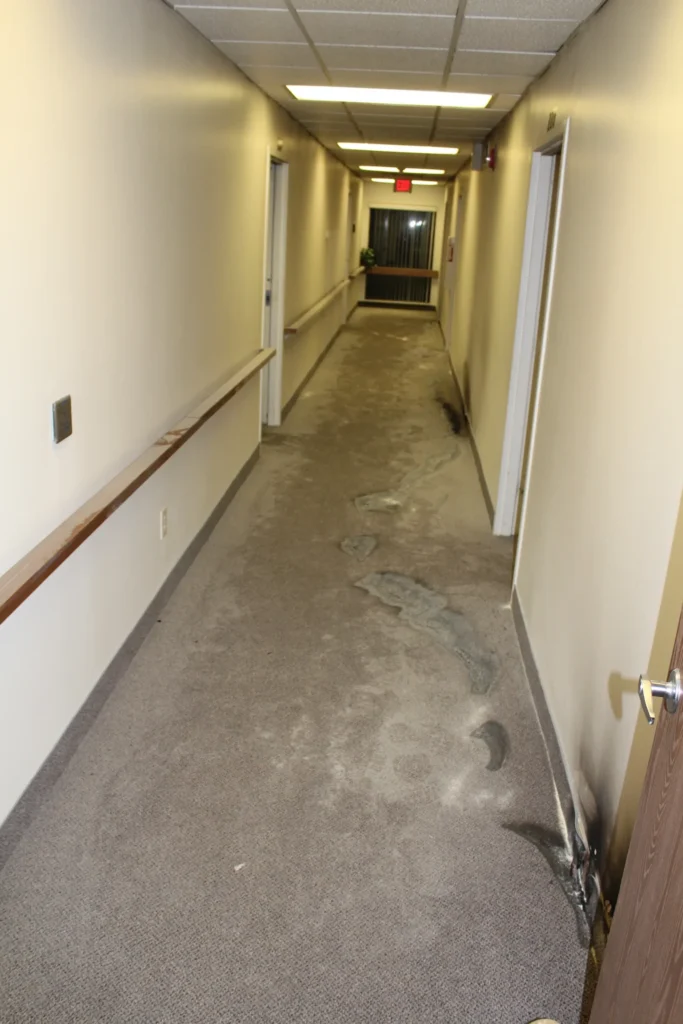
There was obviously a trail of a flammable fluid dripped (“dribbled”) along the right side of the hallway and the outer edges of the down stairwell. Materials only singed or slightly burned within a few inches of where the flammable liquid directly dripped. It was likely a light flammable liquid, like rubbing alcohol or a liquor, leaked from a compromised garbage bag.
This hallway and attached stairwell lead to an exit-only door near the garbage dumpster, passing the pet-relief area and 7.2kV power transformer, as well as adjacent parking lot.
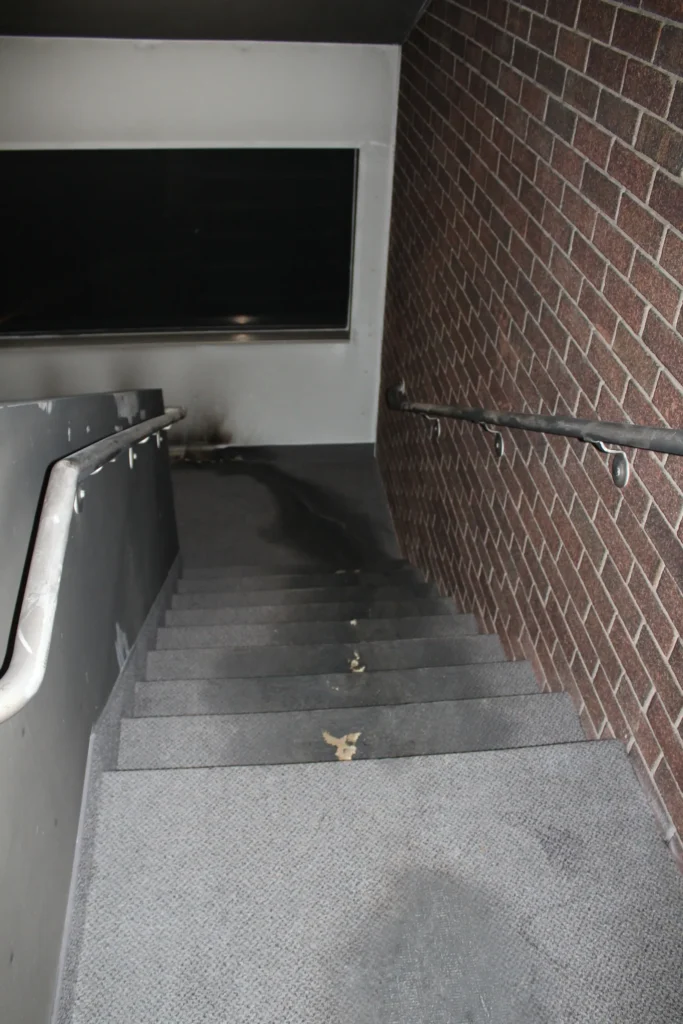
In provided written reports, investigators and officers never explicitly claimed that it was a gasoline fire, but insinuated that it was and verbally attempted to coerce and convince Ron that it absolutely was.
The fire’s full forensic report has not been provided by Prosecution, but Defense has been told that “the partial forensic report is insufficient to make any determination with regard to the quantity/proportions of the alleged accelerant(s).” This means they couldn’t find any gasoline, the alleged accelerant.
Ron was accused by fellow residents within minutes of the fire alarm, possibly because they detected the odor of gasoline residue upon him, he having spilled gas on himself in a church water-well parking lot 2 hours before the fire.
Also, Ron’s truck bed had a jug of gas—the source of the spill on himself—in plain view, with plenty of gasoline still in it AFTER the fire! But why was ANY gas left, if the jug was the “arson fuel” source?
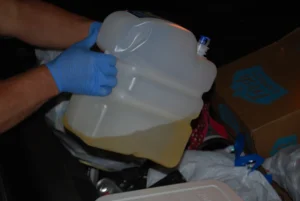
Investigators dismissed and didn’t consider or acknowledge Ron’s account of obtaining the jug of gasoline from an estranged family associate—until prompted to follow up on his statements of facts ONE YEAR LATER, May 30, 2019!
They kept badgering Ron and repeatedly suggested that he bought the gasoline and that he poured it down the hallway and stairwell, despite all evidence to the contrary, along with there being no surveillance footage to suggest that it was even possible for him to pour the gasoline there and ignite it.
The 3 individuals housed within the fire-involved hallway that night didn’t smell gasoline from or in their hall, including one who accused Ron within minutes of the alarm but had not witnessed Ron around the fire area that night.
Those 3 residents did not even know there was a fire until the alarm sounded, a considerable time after it ignited. They did not hear or sense any explosion, smell any smoke or anything else, nor think that anything was wrong, until they heard the alarm.
Investigators have not stated or suggested any approximate time(s) that Ron would have—or could have—poured and spread the gasoline, ignited the fire directly, or set up a method of indirect ignition.
They have not stated or suggested how Ron—or anyone else—managed to avoid being detected or recorded by the indoor and outdoor surveillance cameras or any living witness on the way to the area to distribute the flammable or start the fire.
They claim it was an intentional fire, without providing any evidence to differentiate it from an accidental fire. They have not stated or suggested a motive for this fire in any written reports.
The investigators and the Prosecution have not provided any footage or witnesses showing that Ron—or anyone else—had anything to do with starting the fire, nor of transporting any liquid container into the fire area, nor of pouring a flammable liquid in that area. They have not provided any outdoor surveillance footage from the 2 outside cameras, which are relevant. They have only provided partial footage from 4 indoor cameras, of the total 15 indoor cameras relevant to the case.
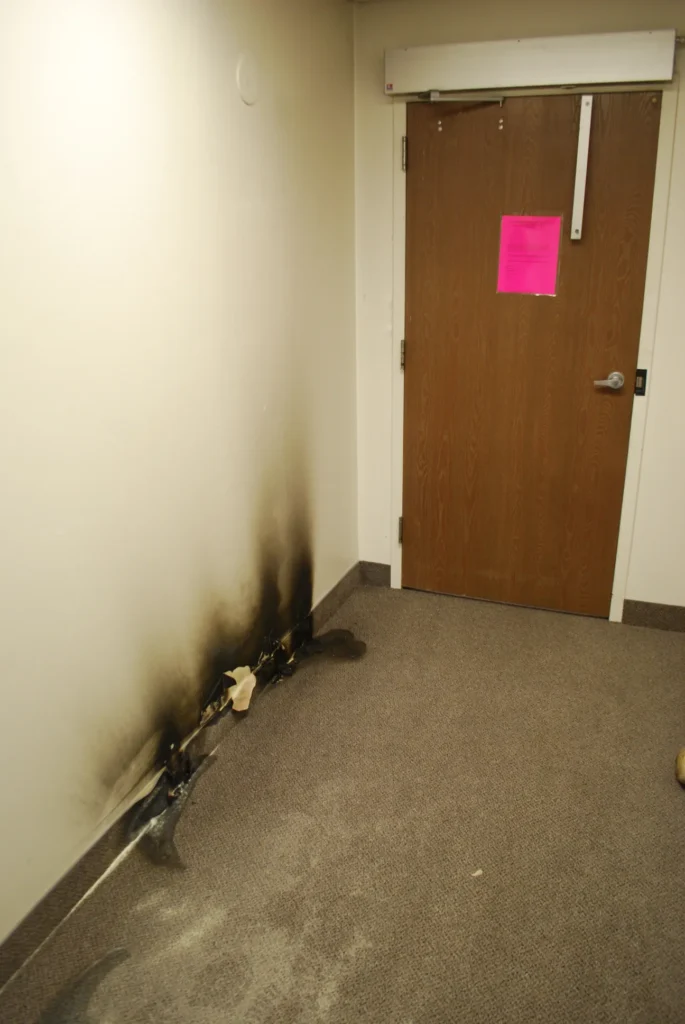
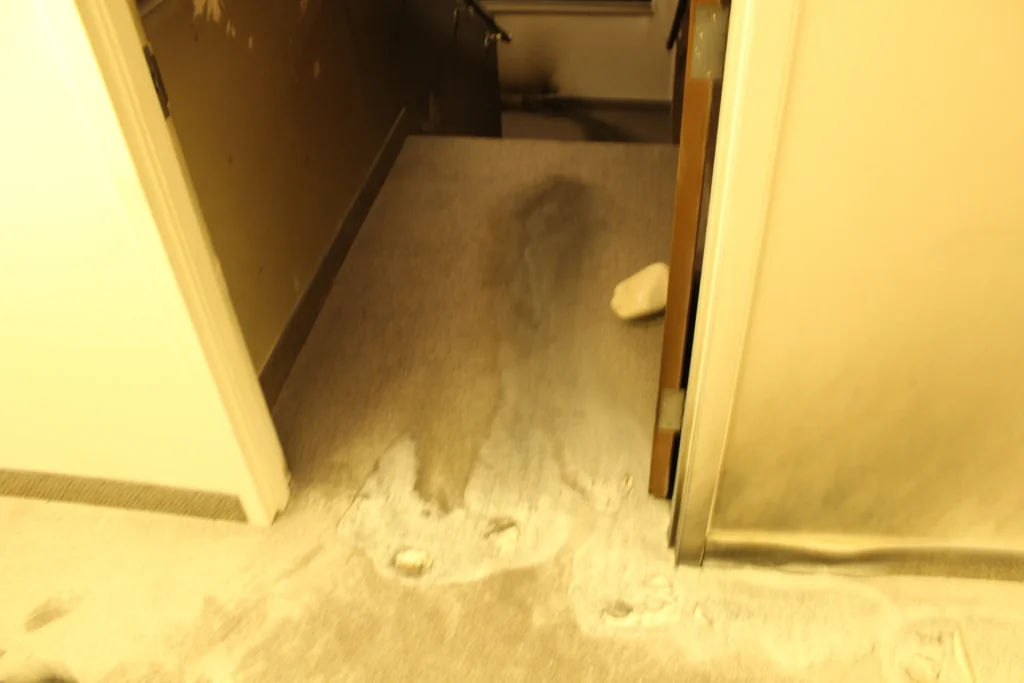
The apparent end of the fuel trail is hand-high on the third step up. This is indicative of an individual with ambulatory difficulties. Such a person would place a garbage bag onto the third step while he propped open the exit-only door with a heavy rock, then retrieve the bag to place it in the dumpster and return, reentering in the same propped doorway.
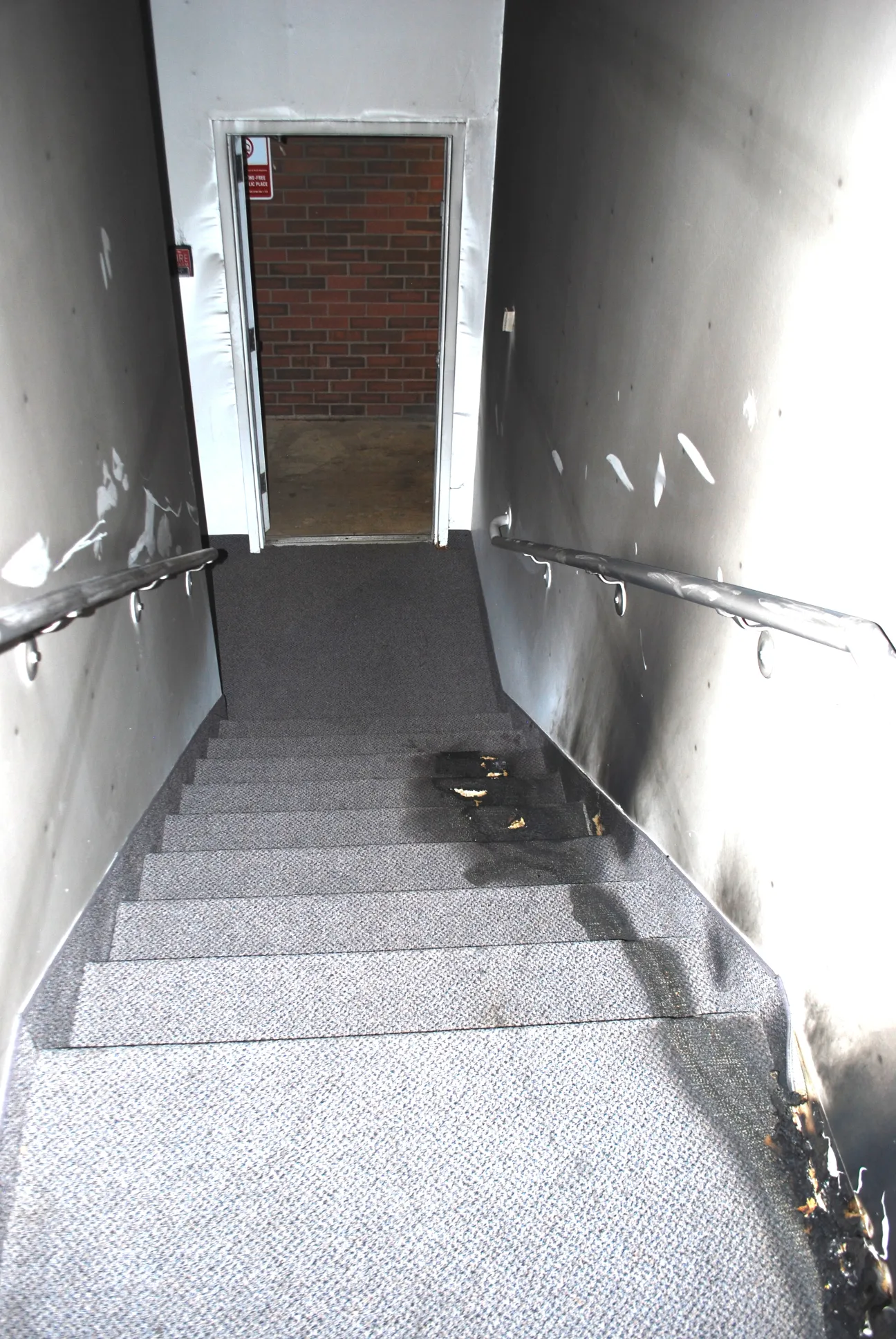
The spilled flammable liquid could have easily ignited through static discharge, a spark from friction from rocks or metals against concrete, a nearby smoker’s light-up or flicked ember, or an inductive/capacitive discharge at the power transformer along that path to the outside dumpster.
The fire alarm activated at 11:47. There has not been the extant discovery provided to indicate that anyone approached the pre-fire area after 10:07pm (when Ron was there and was soon shown elsewhere at 10:10). But someone must have spilled a flammable liquid down the hallway and stairwell, from a leaking trash bag on their way to the dumpster, as indicated below.
Outdoor Surveillance Cameras
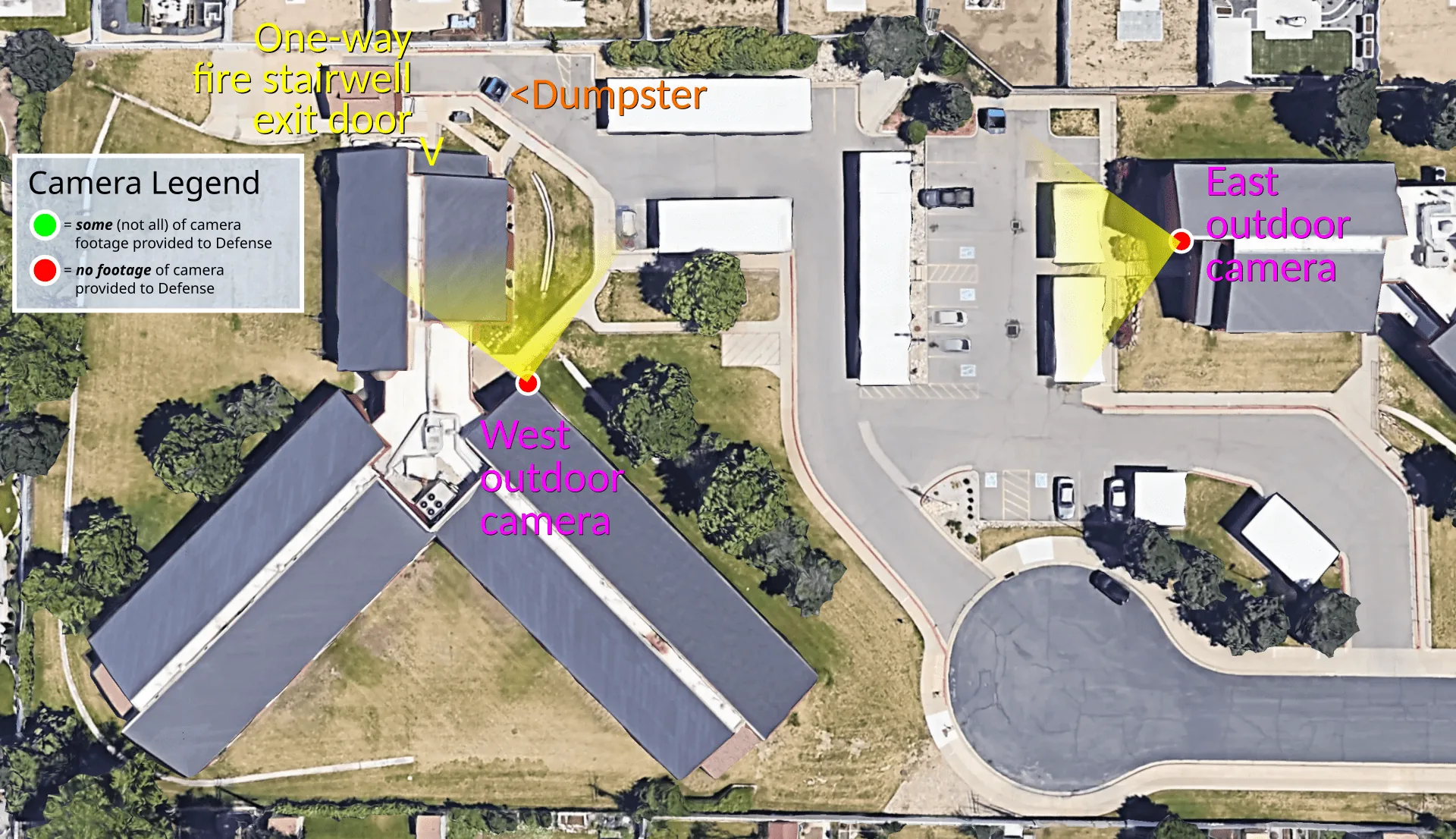
Indoor Surveillance Cameras
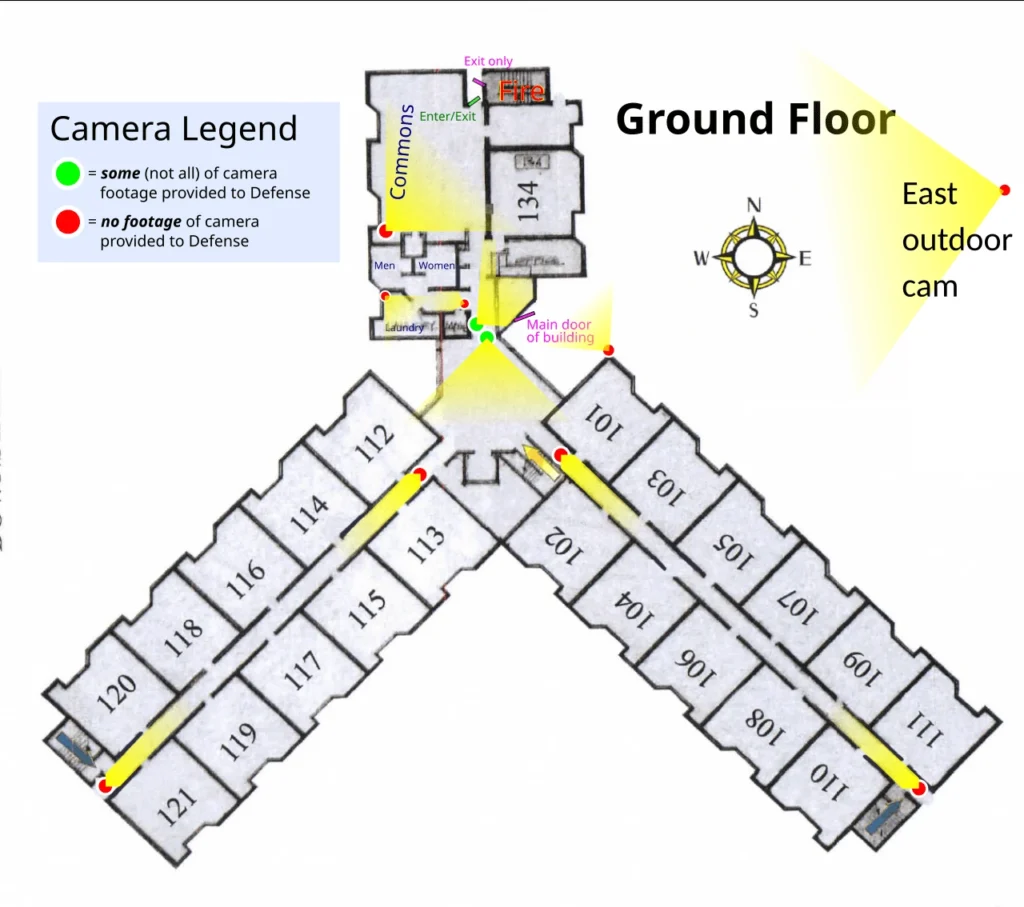
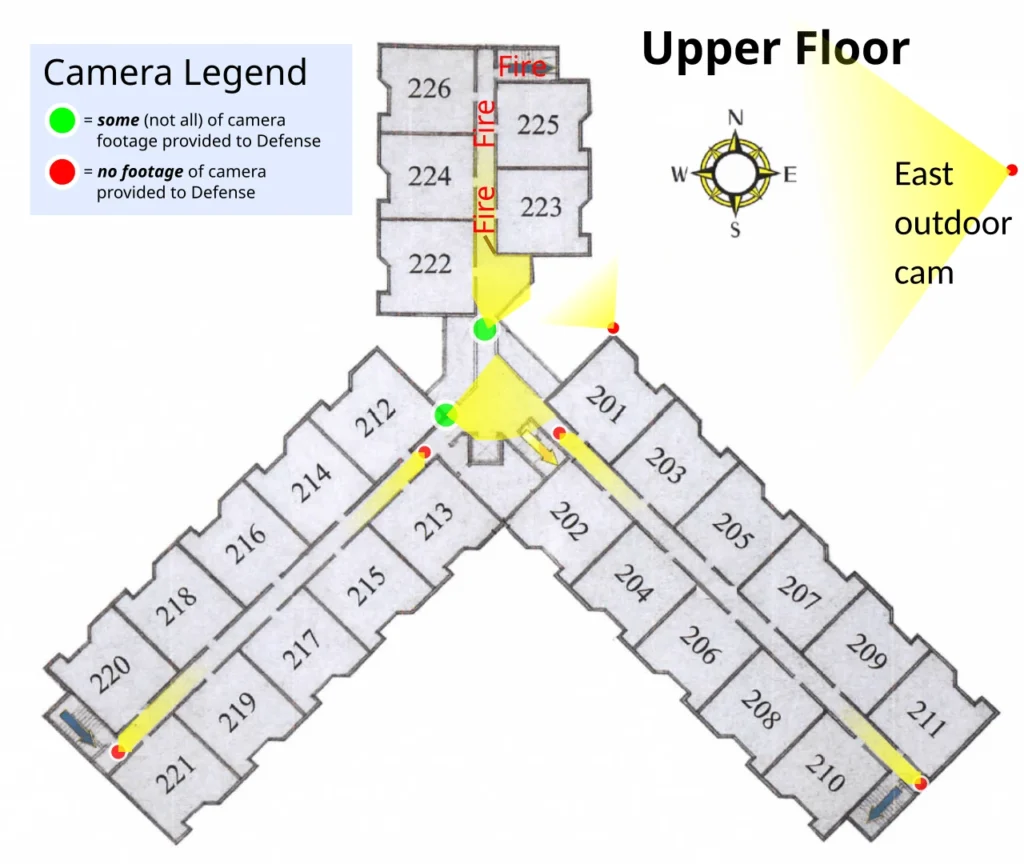
The transit and activities of ~52 residents and their visitors would have been captured in the footage secured by the police and fire investigators in this 24-hour record of all of May 19th, including the individuals and their activities relevant to the fire, and the whole fire episode itself.
The fire alarm activated at 11:47pm, near the very end of the day, which was also the end of the surveillance footage provided; no footage of the next day, May 20th, has been provided. Of the May 19th, 24-hour surveillance footage that the investigators secured, the Defense has only been provided:
- a brief 12:06am video (nearly 24 hours prior to fire);
- two brief selections of the same 7:02am footage with different start/end times (video shown below);
- some of the footage of 4 cameras between 10:07pm through 11:59:59pm.
Start of Provided Footage
Here was Ron’s 1.1-mile walking route around the block between 11:16-11:47pm.
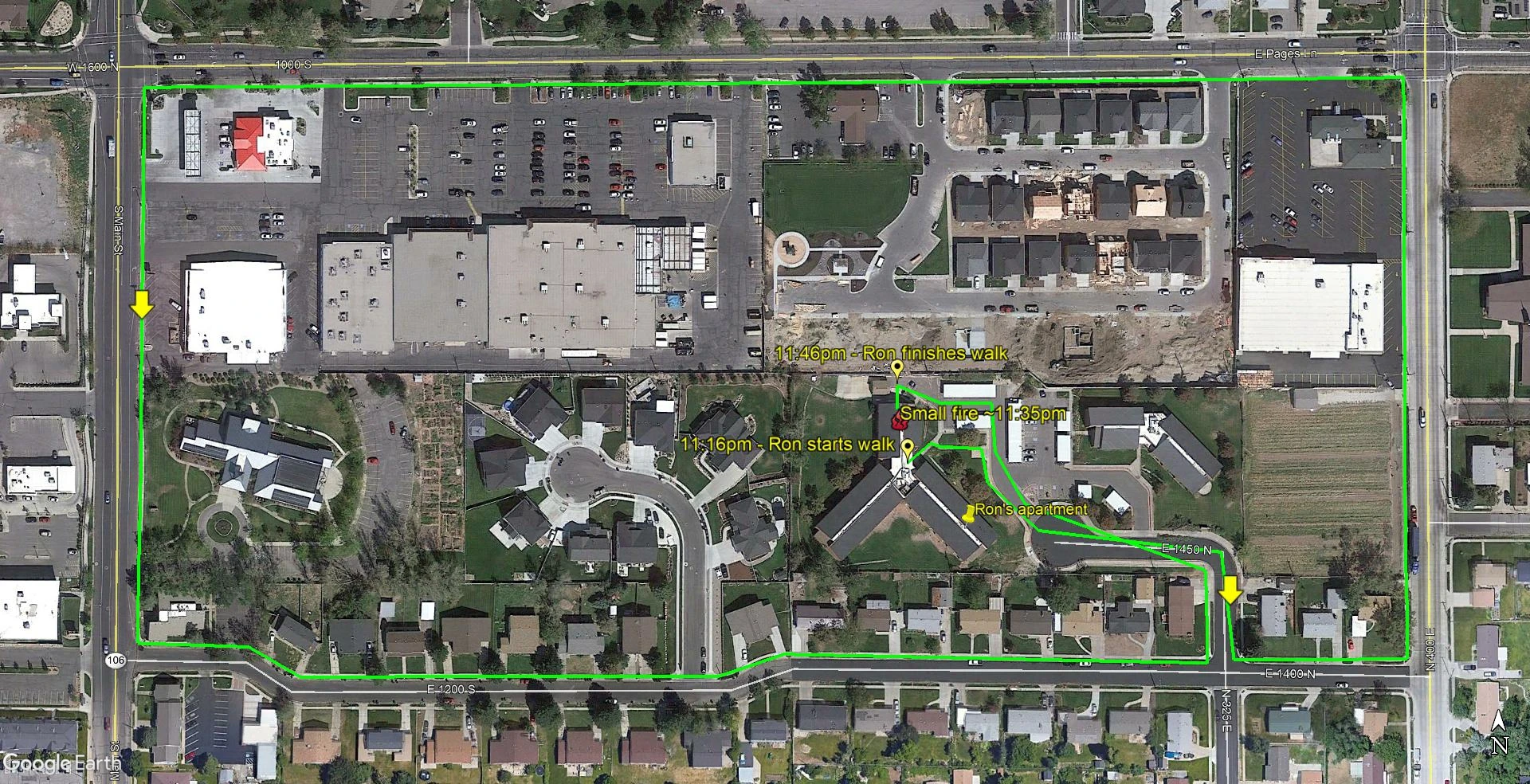
After Ron’s walk around the block, he will return to the north end of the Meadows at 11:47 (only coincidentally, the same moment the fire alarm sounds).
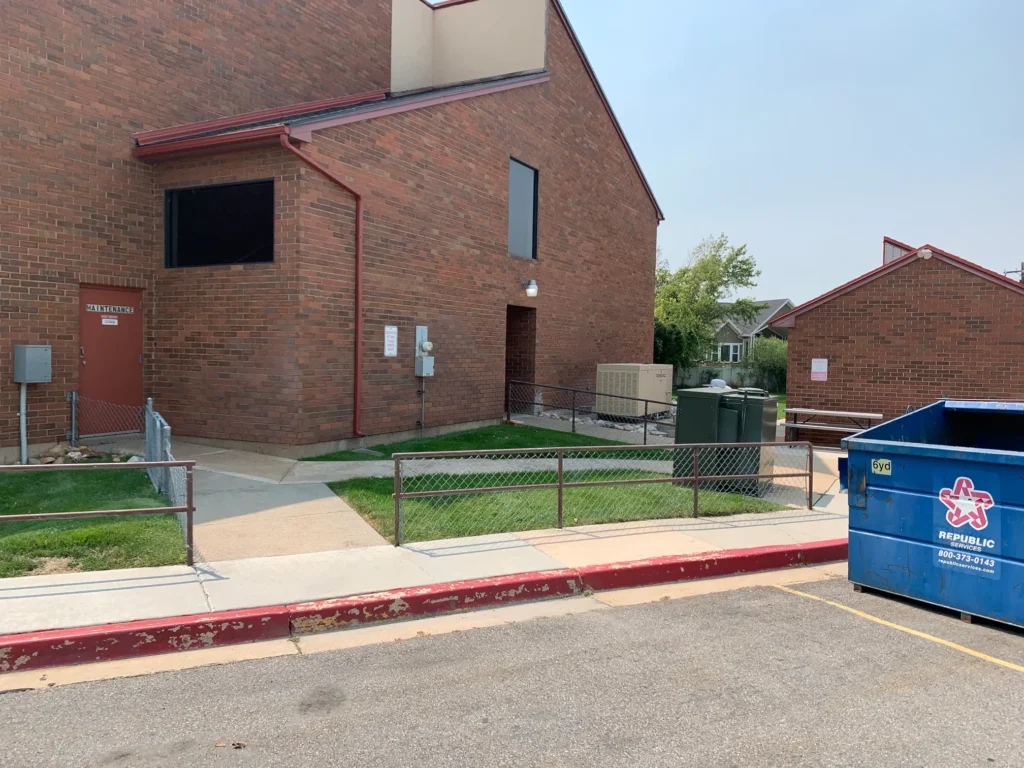
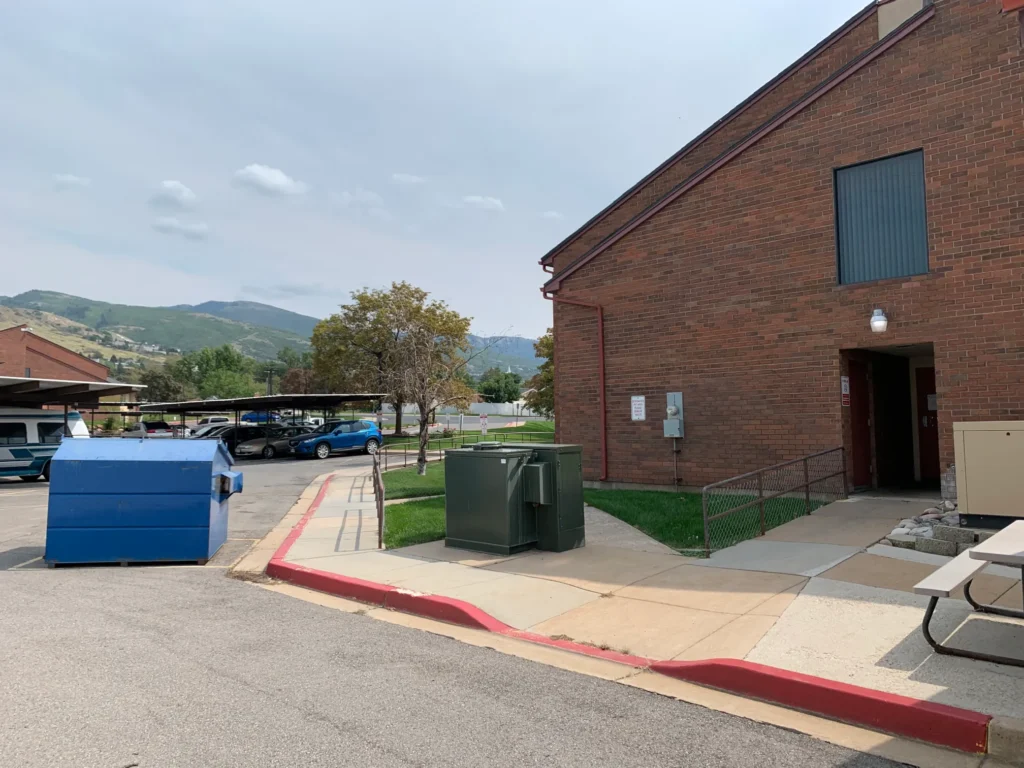
The time is now just seconds before 11:47pm, and Ron has just returned from his late-night walk.
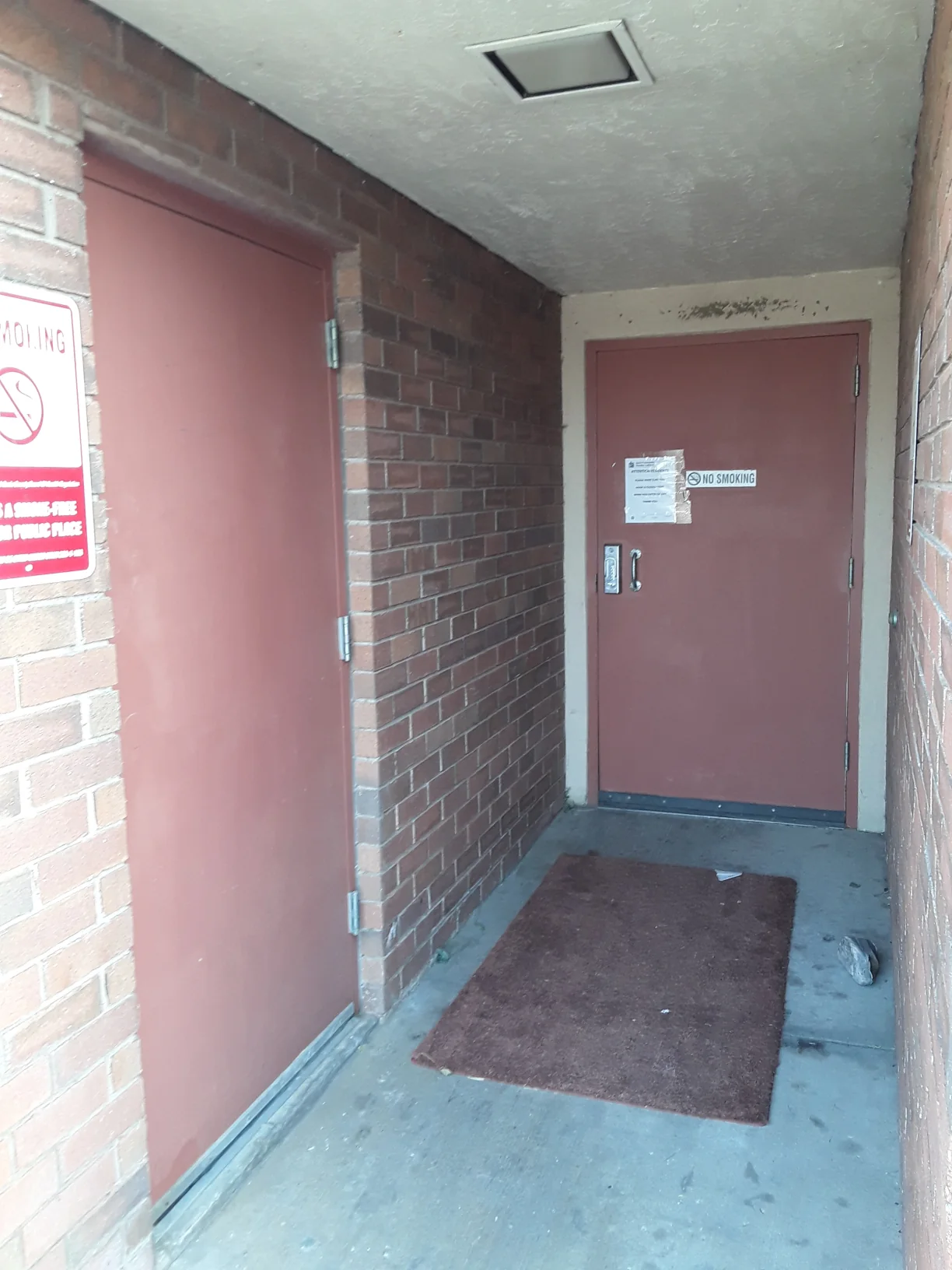
Ron enters this corridor and passes by the first door on the left, the one-way, emergency stairwell exit door.
Notice there is no door handle on the stairwell exit door (left). The only way to open it from outside is to have it previously propped open.
Ron opens and enters the doorway straight ahead (on the right in this photo), into the commons (activity) room. We’ll see him emerge from the commons.
At 11:47pm there is a relatively small fire in the stairwell and in the above hallway. (The window shown here is part of that hallway.) Since the fire was so small, it would have taken many minutes to build up enough smoke to trigger the alarm, which, only coincidentally, sounded within seconds of when Ron entered the commons door.
The Man in Red
The man in red seems to have been involved in the circumstances creating the fire, but even he is innocent! The fire was completely accidental and unexpected.
According to the provided footage, the man in red approached the open firehall entry 1.5min after Ron had fully extinguished the hallway flames.
After being carried out by firemen, the man in red is asked, by an officer, if anyone else is in the fire area, and he responds that there is someone in the hallway, but that claim is never substantiated. His response does not explain why he—with crutches, unable to rescue anyone—initially evacuated at 11:52:50 with most of the residents and then reentered the building alone approximately 3 minutes later (at 11:55:35).
The man in red says someone is still in a room “#136,” a room and room number which does not and did not even exist.
The man in red is also questioned on how the fire started, and he says, “Uh, I guess somebody had some oil that leaked into the, uh, carpet and it [developed?] and smoked everywhere. There’s a fire into that room, I guess that’s it.”
The man in red seems to have thought the hallway fire ignited from a fire inside an apartment, but photos and reports show that only the hallway and stairwell were involved.
When the man in red is asked whether he was around the fire, he says he was “around the small flames over into the hallway.” But according to these footage fractions provided to Defense, the fire was already extinguished before he was near the fire area.
The man in red seems to have familiarity with what happened. He knew enough about the fire because he was obviously intimately involved, as indicated by his recorded dialog and his symptoms of smoke inhalation; but not enough to know what caused it. He appears to be oblivious as to how it actually ignited.
When the man in red is asked, “How come you were right there,” he responds, “I had dropped my crutch, and I can’t really walk with one crutch…. I started feeling nauseous and started [inhaling?] smoke into my lungs.”
Another time, he says, “I dropped one of my crutches and I went back up to grab it and I couldn’t find it. That’s when I started passing out.”
The account of the man in red does not match what is shown in the provided footage, and he must have been in the area of the fire and its resultant smoke earlier (in video denied).
Despite all of the overwhelming evidence that this man in red—the initial suspect—was definitely intimately involved in the early stages of the fire, he was soon dropped as a suspect because people started accusing Ron….
And despite all of the overwhelming evidence that the fire wasn’t a gasoline fire and that Ron wasn’t near the Meadows apartments around the time the fire ignited, Ron was blamed and charged with arson simply because:
- he smelled like gasoline residue from his accidental spill two hours earlier;*
- he had a partially-filled gas jug in open view in his truck bed after the fire;*
- because of the accusatory gossip from unfriendly co-residents;* and
- he couldn’t clearly explain events* because of his expressive difficulties, compounded by chill and stress.
* = had nothing to do with the actual fire!
Investigators and their Investigation
Since investigators observed that the fire involved a trail of flammable liquid, they skipped steps and prematurely concluded that it must have been an arson fire. Then they only looked for signs of an arsonist.
Investigators (and others) smelled the old gasoline residue on Ron and noticed his gas jug in his truck bed, so they blamed him. But they failed to follow their fire investigation training and protocols (NFPA 921 & 1033) and ignored the facts that there were no indications of a gasoline fire at the Meadows and that there were no indications that Ron was near the fire area around the time of ignition.
One of the very first things taught in fire investigation training is that gasoline is the cheapest, most readily-available and most frequently-used accelerant in arson fires. Google: What is the most common accelerant?
As such, investigators are extensively trained how to recognize and deal with true gasoline fires. They know gasoline is an explosive and that gasoline fires cause catastrophic structural damage, with thermal violence.
If a true gasoline fire [see our Gas vs Alcohol Fires page] is compared to the Meadows carpet fire, it is IMPOSSIBLE to misidentify the Meadows fire as a gasoline fire! Even the least experienced investigators would easily know the difference between the Meadows fire and a gasoline fire. They know people cannot possibly linger around or casually walk in and out of the area of a gasoline fire multiple times, as several people did at the Meadows.
If gasoline had been used in the Meadows fire, as the investigators implied, there would have been a very large explosion at the moment of ignition, shattering the windows and compromising the doors and other non-static structure elements, along with extensive fire damage to most of the materials in the immediate area.
Also, if it had been a gasoline fire with the quantity of fuel implied, Ron COULD NOT have extinguished the flames because of the fire’s size and extreme heat and ferocity, and that entire north wing of the building (including the stairwell) would have been engulfed in flames within seconds of ignition.
If gasoline was involved in the fire, as the investigators and Prosecution implied, that part of the building would have been structurally compromised and unsafe to reenter.
But, after allowing for venting and investigation to be completed, residents of the fire-involved hallway were able to return to their apartments by morning, then participate in their regular activities. As usual, their church branch met downstairs that morning (a Sunday) in the commons room, directly beneath where the fire occurred.
The fire caused no structural or usability damage to the building.
Before investigators arrived and performed any investigation, someone had already concluded that Ron was guilty. After they somehow dismissed the culpability of the initial suspect, the investigators pursued only that premature, flawed conclusion of Ron’s guilt. They had decided Ron was guilty before they had opportunity to look at all relevant evidence, and they never considered that the fire was accidental and that Ron was innocent.
ALL of the Meadows building surveillance provided to Defense has been shown in this page’s videos (above). NONE of the provided building surveillance video substantiates any of the charges against Ron Makin, but is certainly deficient of all facts. It demonstrates the act of withholding exculpatory footage.